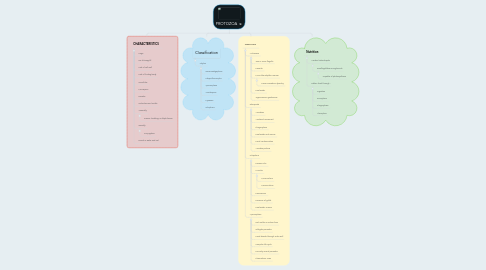
1. CHARACTERISTICS
1.1. Large
1.2. No chloropyhll
1.3. Lack of cell wall
1.4. Lack of fruiting body
1.5. Unicellular
1.6. Microspora
1.7. Parasitic
1.8. Colourless and motile
1.9. Axesually
1.9.1. Fission, budding, multiple fission
1.10. Sexually
1.10.1. Conjugation
1.11. Found in water and soil
2. Classification
2.1. Phylum
2.1.1. Sarcomastigophora
2.1.2. Labyrinthomorpha
2.1.3. Apicomplexa
2.1.4. Ascetospora
2.1.5. Myxozoa
2.1.6. Ciliophora
3. GROUPS
3.1. Archaezoa
3.1.1. Two or more flagella
3.1.2. Parasitic
3.1.3. Move like whiplike manner
3.1.3.1. Cause amoeboic dysentry
3.1.4. Freshwater
3.1.5. Trypanosoma gambiense
3.2. Rhizopoda
3.2.1. Amoebas
3.2.2. Ameboid movement
3.2.3. Phagocytosis
3.2.4. Freshwater and marine
3.2.5. Fecal contamination
3.2.6. Amoeba proteus
3.3. Ciliophora
3.3.1. Possess cilia
3.3.2. 2 Nuclei
3.3.2.1. Micronucleus
3.3.2.2. Macronucleus
3.3.3. Paramecium
3.3.4. Presence of gullet
3.3.5. Freshwater, marine
3.4. Apicomplexa
3.4.1. Not motile in mature form
3.4.2. Obligate parasites
3.4.3. Food absorb through outer wall
3.4.4. Complex life cycle
3.4.5. Primarily animal parasites
3.4.6. Plasmodium vivax
4. Nutrition
4.1. Aerobic heterotrophs
4.1.1. Dinoflagellates & Euglenoids
4.1.1.1. Capable of photosynthesis
4.2. Obtain food through :
4.2.1. Ingestion
4.2.2. Pinocytosis
4.2.3. Phagocytosis
4.2.4. Absorption
